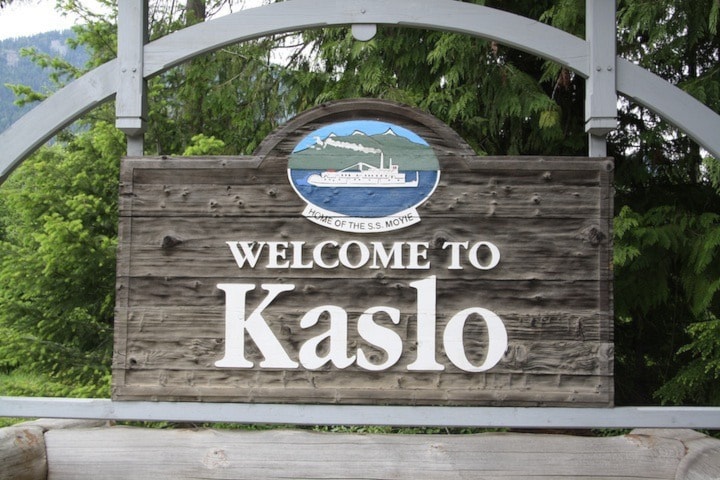Ninety-sixth in a series on West Kootenay/Boundary place names
Last week, we began looking at the origin of Kaslo, first mentioned in 1889 as Caslo.
The Kaslo Claim of June 9, 1893 wrote: “It is surprising how many different ways people spell the name of this city. Here are some of the ways: Caslo, Kasaloo, Kelso, Kalso, Kasslow, O’Kaslo, Kasloo, Kaslien, Caslien, Kissloo, Kisslow, Cashloo, and many others. The proper and official way to spell it is Kaslo, always with a big K.”
George Owen Buchanan, West Kootenay’s early timber baron, addressed the subject in an address to the annual convention of the Boards of Trade in Eastern BC. His speech was reproduced in The Kootenaian on Oct. 30, 1913.
“‘Look for timber on Caslo Creek,’ said Mr. G.M. Sproat, government agent at Revelstoke when I was leaving in May 1888 for my first trip down the Columbia River to Kootenay Lake. He was kind enough to spell the name for me: C-a-s-l-o. ‘I have the information from the late [Robert] Sproule,’ he said … And now as to the name. I have seen old maps in which the name appears spelled with an initial C. Mr. [David] Kane, however, at an early date decided for the use of a K instead …
“Mr. J.W. Cockle derives the name Kaslo from ‘aassassaloo’ which in Kootenay Indian language (Mr. Cockle says) means a ‘raspberry patch.’ This abbreviated (by white men) became ‘sassloo — Caslo – Kaslo.’ Many of us have a more commonplace explanation.
“Within easy memory, old Caslo, an Indian, was living at Bonner’s Ferry. Some few years before our time this Indian, under the auspices of Richard Fry … had spent a winter in trapping marten on Kaslo creek. I have heard his catch stated at 800, and again at 1,500 skins. He had a cabin on the present townsite, and the site of his operations continued to be known as Caslo’s creek. As to the origin of the Indian’s name, I do not know, but I never had any doubt that a good priest (perhaps one of Spanish extraction) christened him ‘Castello.’”
However, when the Geographic Survey of Canada inquired about Kaslo’s name in 1905, postmaster David Kane replied: “Kaslo was named by my brother and myself in the year 1890. Previous to this time my brother and myself staked a pre-emption and a purchase comprising a mile square or 640 acres more or less at the mouth of the river that flows into Kootenay Lake at this point.
“The river was then and had been for many years before named ‘Kaslo’ so we named the town after the river. As to how the river got the name ‘Kaslo’ there does not seem to be any exact proof, but I do know that there is nothing in the fable of ‘where blackberries grow’ as blackberries do not or ever did grow here. In early days I lived alone at this point and for a whole year had nothing but Indians around and not one of them could tell me a word as to how the name originated. The name is not Indian, that is certain.
“What I do know is this: for a time when I was alone here I had an old Frenchman trapper staying with me in the cabin for awhile and he told me that years before when the Hudson Bay Co. came in on this lake to get lead from the Blue Bell Mine for bullets, that there was a Frenchman with their party by the name of John Kaslo or Kasleau, who came up the lake to the head looking for placer gold and had named the river after his name.
“This seems to me to be reasonable as there is traces of old placer workings on the river. I would be inclined to think that ‘Kasleau’ is the right spelling as Lardo at the head of the lake is shortened from ‘Lardeau.’ I could never find any Indian that knew anything about that blackberry story and I know all the old time Indians.”
Next: The search for Johnny Kasleau
Previous installments in this series
Applegrove, Appleby, and Appledale revisited
Bakers, Birds, and Bosun Landing
Bannock City, Basin City, and Bear Lake City
Bealby Point (aka Florence Park) revisited
Boswell, Bosworth, Boulder Mill, and Broadwater
Brooklyn, Brouse, and Burnt Flat
Camborne, Cariboo City, and Carrolls Landing
Carmi, Cedar Point, Circle City, and Clark’s Camp
Carson, Carstens, and Cascade City
Christina City and Christian Valley
Cody and Champion Creek revisited
Champion Creek revisited, again
Columbia City, Columbia Gardens, and Columbia Park
Crawford Bay and Comaplix revisited
Dawson, Deadwood, and Deanshaven
English Cove and English Point
Forslund, Fosthall, and Fairview
Fort Shepherd vs. Fort Sheppard, Part 1
Fort Shepherd vs. Fort Sheppard, Part 2
Gladstone and Gerrard, revisited
Granite Siding and Granite City
Hall Siding and Healy’s Landing
Hudu Valley, Huntingtdon, and Healy’s Landing revisited
Inonoaklin Valley (aka Fire Valley)
